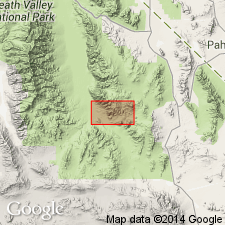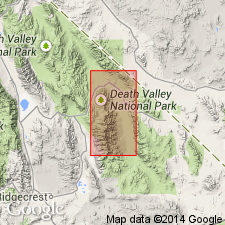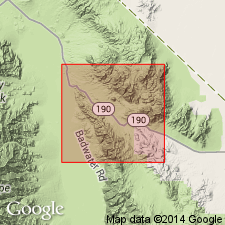
- Usage in publication:
-
- Artist Drive formation*
- Modifications:
-
- Original reference
- Dominant lithology:
-
- Basalt
- Tuff
- Clay
- Limestone
- AAPG geologic province:
-
- Great Basin province
Summary:
Pg. 955-956. Artist Drive formation. Comprises 1,000 feet or more of impure well-stratified ash beds that contain remains of fresh-water fish. Conformably overlain by alternating basaltic and latitic flows, tuffs, and breccias that are more or less altered. Interlain with volcanic rocks are basin deposits that range from fanglomerate to playa clay and algal limestone. Unconformably underlies Furnace Creek formation. Name credited to T.P. Thayer. Tentatively correlated with Oligocene Titus Canyon formation of Stock and Bode (1935) but may be in part Miocene.
Typically exposed in west face of Black Mountains near Artist Drive in Death Valley, Inyo Co., eastern CA.
Source: US geologic names lexicon (USGS Bull. 1200, p. 145); supplemental information from GNU records (USGS DDS-6; Menlo GNULEX).

- Usage in publication:
-
- Artist Drive Formation*
- Modifications:
-
- Age modified
- AAPG geologic province:
-
- Great Basin province
Summary:
Referred to as Artist Drive Formation of Noble and Wright (1954) (Oligocene(?) to early Pliocene). Uppermost tongue of playa beds in Artist Drive Formation has yielded diatoms indicating early Pliocene age. Fossils were collected from hard thin limestone from center W/2 NE/4 sec.7 T26N R2E, Furnace Creek 15' quad, Inyo Co, CA. Mapped undivided with volcanic rocks in north part of Black Mountain where age assigned is Oligocene(?).
Source: GNU records (USGS DDS-6; Menlo GNULEX).

- Usage in publication:
-
- Artist Drive Formation*
- Modifications:
-
- Areal extent
- AAPG geologic province:
-
- Great Basin province
Summary:
Map shows 7 informal lithologic subdivisions of unit in Furnace Creek borate area; three sedimentary units are separated by two pyroclastic units. Felsite and basaltic units recur as flows, sills, dikes, and volcanic necks in different parts of Artist Drive Formation. Age is discussed. Lohman (written commun., 1954, 1961, 1967) concludes best age assignment for assemblage of 11 diatom genera from uppermost part of unit early Pliocene (Clarendonian). Overall age is Oligocene(?) to early Pliocene.
Source: GNU records (USGS DDS-6; Menlo GNULEX).
For more information, please contact Nancy Stamm, Geologic Names Committee Secretary.
Asterisk (*) indicates published by U.S. Geological Survey authors.
"No current usage" (†) implies that a name has been abandoned or has fallen into disuse. Former usage and, if known, replacement name given in parentheses ( ).
Slash (/) indicates name conflicts with nomenclatural guidelines (CSN, 1933; ACSN, 1961, 1970; NACSN, 1983, 2005, 2021). May be explained within brackets ([ ]).

